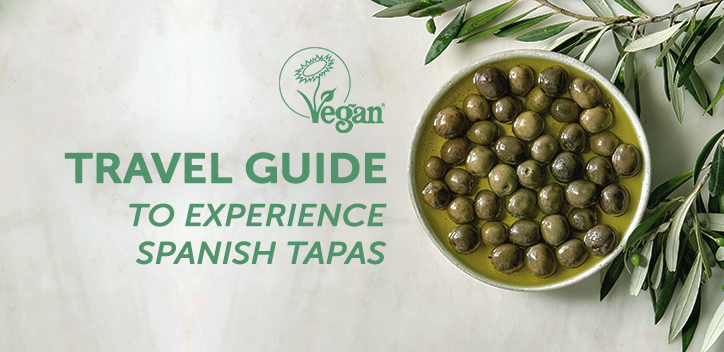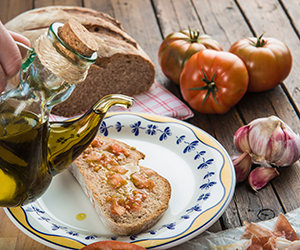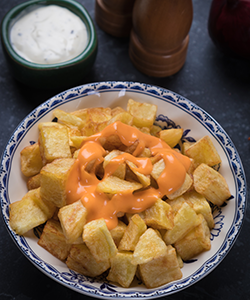
How you can make Spanish tapas vegan
Spain is a very popular summer destination for many reasons: lots of sun, tasty food, rich and diverse culture, beautiful cities and natural landscapes. Naturally, it had to feature in our collection of Vegan travel guides and, thankfully, there are an array of Vegan Trademark certified products available to make tapas dishes this summer (and all year – they’re that good!)
Spanish cuisine is a very big part of our culture and something that whether you're travelling or living there, you should experience. Unfortunately, most of the Spanish traditional dishes aren’t vegan. But don’t you worry - we’ve put together this Vegan Travel Guide to experience Spanish food, so you don’t miss out on anything! Remember to look for the Vegan Trademark on products – reading ingredient lists can be confusing enough in your first language, so save the hassle and rest assured that when you see our trademark, we have confirmed it is free from animal ingredients and we ensure no animal testing has been conducted at the initiative of the brand or on their behalf, or by parties over whom the company has effective control.
Whether you’re travelling to Spain or staying home but wanting to get a taste of Spanish food, we got you.
The products mentioned in this post are available in Spain (in supermarkets or small shops) and in the UK. We’ve tried to make it as accessible as possible, whether you are in Spain, or in the UK, and wanting to still experience some of that Spanish flavour. Some of the products might just be available in one of the countries, and therefore we’ve mentioned more than one alternative.
Popular Spanish Tapas by Region: veganised
The most famous Spanish tapas are probably the croquetas and tortilla de patata. These two aren’t usually vegan, but you can easily make vegan Spanish croquetas by switching the ingredients for vegan-trademarked alternatives.
- For the bechamel: Alpro’s Soy Milk no-sugar (Spain and UK) and Violife’s Vioblock Plant-based butter alternative (Spain and UK).
- To substitute the meat, you can use these for vegan “chicken” croquetas: Chicken Style Pieces from Lazy vegan (UK only) and Morrisons Plant Revolution Roast No Chick'N Pieces (UK only). Or you can also either use these vegan bacon alternatives from ASDA (UK only), soya chunks or mince some seitan, such as this one from La Finestra sul Cielo (Spain).
Making tortilla de patatas can be quite an experience, since it’s all about cutting and frying the potatoes into thin pieces, with some onion, mixing it with an egg alternative, such as Crackd’s No-Egg Egg, and cooking it in a frying pan. The secret is for the tortilla (omelette) to be cooked, but not too much, just enough to stay consistent, but still saucy and not dry at all.
Spain is well known for its diversity across regions, so we’ve put together a few veganised Spanish tapas, some traditionally from specific regions of Spain:
Catalunya: Pa amb tomàquet, Bomba catalana
 “Pa amb tomàquet” is something that you may find as a vegan tapa option around in Spain, but it’s originally known to be from Catalonia. It’s as simple as toasted bread with fresh tomato grated and spread on top with olive oil and salt.
“Pa amb tomàquet” is something that you may find as a vegan tapa option around in Spain, but it’s originally known to be from Catalonia. It’s as simple as toasted bread with fresh tomato grated and spread on top with olive oil and salt.
The “bomba catalana” is a fried mix of potato and meat, shaped in a form of a sphere of about 5 cm, and served with some “allioli” (or garlic mayo) and “salsa brava”. It’s a local tapa from Barcelona, originated in the area of the Barceloneta.
You can easily make vegan Catalan “bomba” by switching the animal meat by a vegan alternative, such as:
- Soy chunks (easily found in supermarkets),
- or ALDI’s Plant Menu Meat-free Mince (only available in certain regions in the UK).
It’s often cooked with a splash of white wine, so Chardonnay Muscat Ecológico (Spain and UK) or Verdejo Ecologico (Spain and UK) from Neleman are good vegan wine options for this recipe.
La Rioja: Patatas a la riojana
Situated in the north of Spain, La Rioja is known for its wines. A famous dish in that region is “Patatas a la Riojana”, which is a heart-warming and easy to make stew consisting of potatoes and chorizo.
In case you visit this lovely destination, but can’t find any vegan patatas a la riojana, you can easily make it at home or in your Airbnb's kitchen by substituting the chorizo with a vegan alternative, such as LifeFood’s Organic Rawsage (Spain and UK).
Tapas dishes you can make with simple at-home ingredients:
Galicia: Pimientos del padrón
"Pimientos del padrón” are a variety of green peppers of around 5cm, very popular in Galicia, in the north of Spain. They get that name because when they arrived to Galicia from the Americas in the 16th century, they were cultivated in the surroundings of Padrón, a historical town about half an hour drive from Santiago de Compostela.
There’s a saying in Galician (language spoken in Galicia, aside from Spanish), which goes “Os pementos de Padrón, uns pican e outros non”, meaning “Padrón peppers, some are spicy, and some are not”. This is because, and here goes a fun fact about those peppers, some of them are spicy, and some aren’t, and you never know. This makes eating them as a side/tapa a very fun experience.
These are usually served vegan, either grilled or roasted, with some olive oil and salt.
Castilla-La Mancha: Pisto Manchego
Pisto is a savoury classic of Spanish gastronomy. It’s very easy to make, and most often vegan, so this is a bite of Spanish flavour that you will be able to try in bars and restaurants in Spain.
It consists of pan-fried vegetables, the base of which are: tomato, pepper, garlic, onion and courgette, all cut into small pieces and slowly cut in olive oil until soft and saucy. It works well on top of a bread slice, or as a side on bigger dishes.
Madrid: Patatas bravas
 Patatas bravas is one of the most popular tapas in Spain, and the one that you’ll most likely find in any bar or restaurant.
Patatas bravas is one of the most popular tapas in Spain, and the one that you’ll most likely find in any bar or restaurant.
Patatas bravas can be easily made vegan, but the sauce that you get in the bar when ordering might have some meat stock, so it’s worth asking.
You can easily make patatas bravas sauce yourself by frying some potatoes (cut in small cubes, rather than the traditional French fries shape) and preparing this very easy sauce, made of: Spicy “Pimenton” (a spice that’s used to give flavour chorizo, quite like paprika), onion, flour (for thickness), olive oil, garlic and vegetable stock.
It’s pretty much like doing a bechamel, but thinner, and using pimenton to season it and vegetable stock instead of milk. First pan-fry some onion and garlic in olive oil or vegan butter, add the pimenton, add some flour, and then slowly add the liquid stock. All of this while stirring.
Extremadura: Migas extremeñas
Migas extremeñas are the vegan-friendly version of Andalusian migas. This simple, yet flavourful dish consists of leftover bread, oil, garlic and pepper. This was traditionally made to avoid throwing away leftover bread, once it was dry.
The bread is hydrated in water and minced, and then slowly pan fried with the rest of the ingredients. It’s a very nice side for an “aperitivo”.
Andalucía: Pinchos morunos and Salmorejo
If you go to Andalucia, in the south of Spain, you must try their salmorejo. It’s a refreshing cold soup that will forever stay in your mind when you think of a “Spanish summer”. It’s often vegan, but be sure to check, just in case (see box with useful phrases for vegans in Spanish at the end of the blog).
Something you can’t miss either are Pinchos Morunos. These are traditionally not vegan, since they consist of meat sticks, with influences from North Africa, especially Morocco. You can make your own vegan version of those by placing seitan chunks or these Quorn’s Vegan Pieces (UK only) on little sticks, and cooking them with the following spices: cumin, dried parsley, black pepper, ginger, sweet paprika, hot paprika and cinnamon.
Comunidad Valenciana: Paella
Even though it’s not considered a “Tapa”, paella is well known around the world as a Spanish dish that everyone loves.
It’s originally from Comunidad Valenciana, in the East of the peninsula. And even though it’s generally not vegan (cooked with sea fish and fish stock, sometimes meat...), you can easily get similar flavours by following a regular paella recipe, and using some seaweed, such as Nori sheets, to give it that fishy flavour.
Vegan-friendly destinations in Spain
Sometimes it’s hard to find the perfect destination for us vegans, since, during the whole planning, we have to keep in mind and throw into the mix the food. Finding vegan-friendly destinations around the world is perfectly possible, but sometimes it is hard to see which areas might be the ones where the experience will be smoothest. According to an article from Vegconomist, these are the four Spanish cities considered amongst the best in Europe: Madrid, Valencia, Seville and Barcelona.
USEFUL SPANISH PHRASES: These simple phrases will help you ask for vegan food, on restaurants in Spain.
- “¿Es vegano?” – “Is it vegan?”.
- “Soy Vegano” (male) / “soy vegana” (female) - “I’m vegan”.
- “No como marisco, pescado ni carne” - “I do not eat seafood, fish or meat”.
- “No como huevos ni lácteos” - “I do not eat eggs or dairy products”.
- “No como ningún producto derivado del animal (nada de miel, leche, mantequilla, queso, huevos, carne, pescado ni marisco)” – “I do not eat any animal products (no honey, milk, butter, cheese, eggs, meat, fish or seafood)”.
- “¿Hay algo de ____ en esto?” - “Is there any _____ in this?”. “¿Tiene alguna opción vegana?” - “Do you have any vegan options?”.
We hope you’ve found this useful, and whether you are travelling to Spain this summer, or enjoying these dishes at home, we hope this has given you some inspiration.
Don’t forget to share your pictures enjoying your vegan Spanish food and tag @vegantrademark on Instagram or Twitter to join in the conversation. You can also check us out on Pinterest and follow our Vegan Travel Guides board for more vegan tips on other amazing travel destinations.
By Nora Rodriguez, Marketing Assistant
The views expressed by our bloggers are not necessarily the views of The Vegan Society.

